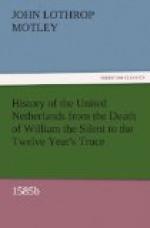This large south-western section of the Netherlands being thus permanently re-annexed to the Spanish crown, while Holland, Zeeland, and the other provinces, already constituting the new Dutch republic, were more obstinate in their hatred of Philip than ever, there remained the rich and fertile territory of Flanders and Brabant as the great debateable land. Here were the royal and political capital, Brussels, the commercial capital, Antwerp, with Mechlin, Dendermonde, Vilvoorde, and other places of inferior importance, all to be struggled for to the death. With the subjection of this district the last bulwark between the new commonwealth and the old empire would be overthrown, and Spain and Holland would then meet face to face.
If there had ever been a time when every nerve in Protestant Christendom should be strained to weld all those provinces together into one great commonwealth, as a bulwark for European liberty, rather than to allow them to be broken into stepping-stones, over which absolutism could stride across France and Holland into England, that moment had arrived. Every sacrifice should have been cheerfully made by all Netherlanders, the uttermost possible subsidies and auxiliaries should have been furnished by all the friends of civil and religious liberty in every land to save Flanders and Brabant from their impending fate.
No man felt more keenly the importance of the business in which he was engaged than Parma. He knew his work exactly, and he meant to execute it thoroughly. Antwerp was the hinge on which the fate of the whole country, perhaps of all Christendom, was to turn. “If we get Antwerp,” said the Spanish soldiers—so frequently that the expression passed into a proverb—“you shall all go to mass with us; if you save Antwerp, we will all go to conventicle with you.”
Alexander rose with the difficulty and responsibility of his situation. His vivid, almost poetic intellect formed its schemes with perfect distinctness. Every episode in his great and, as he himself termed it, his “heroic enterprise,” was traced out beforehand with the tranquil vision of creative genius; and he was prepared to convert his conceptions into reality, with the aid of an iron nature that never knew fatigue or fear.
But the obstacles were many. Alexander’s master sat in his cabinet with his head full of Mucio, Don Antonio, and Queen Elizabeth; while Alexander himself was left neglected, almost forgotten. His army was shrinking to a nullity. The demands upon him were enormous, his finances delusive, almost exhausted. To drain an ocean dry he had nothing but a sieve. What was his position? He could bring into the field perhaps eight or ten thousand men over and above the necessary garrisons. He had before him Brussels, Antwerp, Mechlin, Ghent, Dendermonde, and other powerful places, which he was to subjugate. Here was a problem not easy of solution. Given an army of eight thousand, more or less, to reduce therewith in the least possible time, half-a-dozen cities; each containing fifteen or twenty thousand men able to bear arms. To besiege these places in form was obviously a mere chimera. Assault, battery, and surprises—these were all out of the question.




